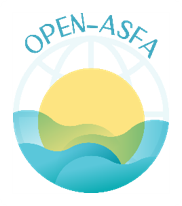Pigmentary potential of various inland water microalgae and their applications (Tunisia)
DOI:
https://doi.org/10.71754/instm.bulletin.v44.447Keywords:
Carotenoids, Vitamins, Strains, Feed composition, Chlorophylls, Accumulation, Phytoplankton, Antioxidants, Pigments, Molecules, Inland waters, Cancer, Diseases, Habitats, Marine, Cylindrospermopsis raciborskii, Dunaliella, MED, TunisiaAbstract
Nowadays there is an increasing demand for microalgal natural products, such as pigments, colorants, antioxidants and vitamins, for commercial use in the food and feed industry as well as in the pharmaceutical, nutraceutical and cosmetic sectors. Thereby, in order to select candidate strains with interesting accumulation levels of pigments (phycobiliproteins, carotenoids, chlorophylls) as valuable molecules, investigations were carried out and focused on 11 inland water microalgal strains isolated from different aquatic habitats. Ten strains belonged to cyanobacteria (Oscillatoriales, Nostocales and Chroococcales) and one to Chlorophyceae (Chlamydomonadales). Results showed that the cyanobacterium Cylindrospermopsis raciborskii, was found to be a very rich natural reservoir of C-phycocyanin (PC) with an amount reaching to 2.87 mg/ml. This level is tenfolds higher than the other two phycobiliprotein groups combined (Allophycocyanin and Phycoerythrin) and about two-folds higher compared with the PC amount in all the 10 other strains together. This result is of particular interest for the therapeutic and pharmacological fields given the extremely health beneficial properties attributed to this phycobiliproteins group including anticancer, anti-inflammatory, neuroprotective and hepatoprotective effects as highlighted in many studies. On the other hand, results also indicated that the unicellular green microalgae, Dunaliella sp., was the top producer strain of four among the pigments analyzed in the present study (Allophycocyanin, total carotenoids as well as the two forms of chlorophyll a and b). This strain represents, thus, an excellent source of these very valuable pigments regarding their role in the prevention of numerous chronic and degenerative diseases such as cardiovascular diseases, diabetes, osteoporosis and several types of cancer (Lung, prostate, colon, breast, gastrointestinal, cervical, ovarian and pancreatic cancers) as proved in several epidemiological studies












